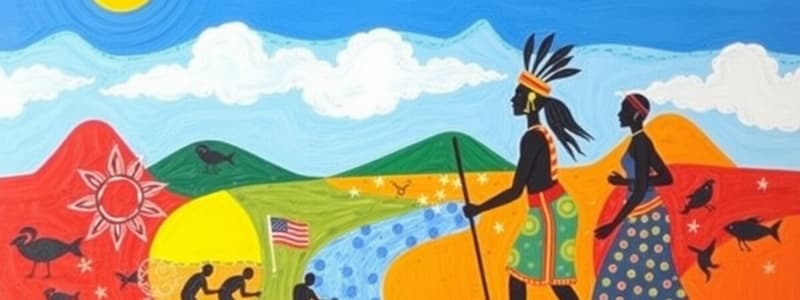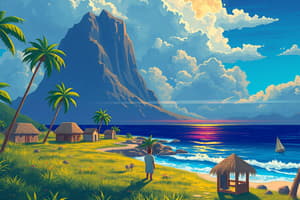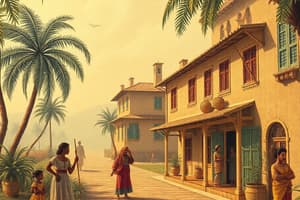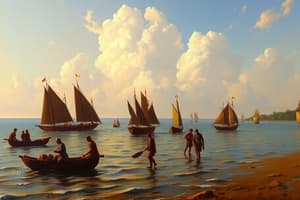Podcast
Questions and Answers
What was the primary role of the Cacique in Taino society?
What was the primary role of the Cacique in Taino society?
- He was a military leader only.
- He was mainly responsible for farming.
- He managed trade relations with other islands.
- He served as a judge, high priest, and settled disputes. (correct)
Which statement about Taino warfare is accurate?
Which statement about Taino warfare is accurate?
- The Taino only waged war against the Kalinago.
- The Taino were not involved in any conflicts.
- The Taino communities sometimes fought each other for resources. (correct)
- The Taino waged war using advanced military technology.
What was a common method of farming used by Taino women?
What was a common method of farming used by Taino women?
- Slash and burn farming. (correct)
- Guerilla farming techniques.
- Hydroponics farming.
- Aquaponics.
What physical characteristic distinguished the Kalinago from the Taino?
What physical characteristic distinguished the Kalinago from the Taino?
Which form of communication was considered important to the Taino culture?
Which form of communication was considered important to the Taino culture?
How were Taino houses typically constructed?
How were Taino houses typically constructed?
What type of spirits did the Taino believe in?
What type of spirits did the Taino believe in?
What was a key component of Taino diet?
What was a key component of Taino diet?
What role did women primarily play in the social organization of the village settlement?
What role did women primarily play in the social organization of the village settlement?
How were leaders chosen in the village settlement?
How were leaders chosen in the village settlement?
Which of the following best describes the religious beliefs of the village settlement?
Which of the following best describes the religious beliefs of the village settlement?
What was one of the customs practiced as part of the initiation into manhood?
What was one of the customs practiced as part of the initiation into manhood?
What structural design is characteristic of the houses built by the community?
What structural design is characteristic of the houses built by the community?
How did the indigenous people initially perceive Columbus and his men upon their arrival?
How did the indigenous people initially perceive Columbus and his men upon their arrival?
What action did Columbus take with some of the indigenous people after discovering them?
What action did Columbus take with some of the indigenous people after discovering them?
What might have contributed to the deaths of the Spanish men left in Hispaniola?
What might have contributed to the deaths of the Spanish men left in Hispaniola?
Which indigenous group is often credited with the name of the Caribbean?
Which indigenous group is often credited with the name of the Caribbean?
What was the primary reason for the migratory patterns of indigenous people into the Caribbean?
What was the primary reason for the migratory patterns of indigenous people into the Caribbean?
What vessel type did the indigenous Taino and Kalinago people likely construct for their travels?
What vessel type did the indigenous Taino and Kalinago people likely construct for their travels?
Where did the Taino people primarily settle in the Caribbean?
Where did the Taino people primarily settle in the Caribbean?
Which geographical feature did early indigenous people cross to migrate into the Americas?
Which geographical feature did early indigenous people cross to migrate into the Americas?
In which islands did both the Taino and Kalinago people establish settlements?
In which islands did both the Taino and Kalinago people establish settlements?
What misconception might some have regarding the migratory patterns of Caribbean indigenous peoples?
What misconception might some have regarding the migratory patterns of Caribbean indigenous peoples?
What significant event marked the beginning of the European presence in the Caribbean?
What significant event marked the beginning of the European presence in the Caribbean?
What was the primary reason for the increased importation of Africans to the Caribbean by the 1520s?
What was the primary reason for the increased importation of Africans to the Caribbean by the 1520s?
What transportation route were Africans forced to travel to reach the Americas?
What transportation route were Africans forced to travel to reach the Americas?
When were Africans emancipated in the British Caribbean?
When were Africans emancipated in the British Caribbean?
What happened when slaves were emancipated in large Caribbean countries?
What happened when slaves were emancipated in large Caribbean countries?
Why was the importation of African workers eventually discontinued?
Why was the importation of African workers eventually discontinued?
Which group was willing to work on plantations after the emancipation of slaves?
Which group was willing to work on plantations after the emancipation of slaves?
What was one consequence of Indian immigration to the Caribbean?
What was one consequence of Indian immigration to the Caribbean?
Why did planters complain about Chinese workers?
Why did planters complain about Chinese workers?
Flashcards
Pre-Columbian period
Pre-Columbian period
The time before Columbus arrived in the Americas, before 1492.
Taino people
Taino people
Indigenous group in Hispaniola (Haiti and Dominican Republic) encountered by Columbus.
Kalinago people
Kalinago people
Another indigenous group in the Caribbean, often called Caribs.
Caribbean Diaspora
Caribbean Diaspora
Signup and view all the flashcards
Bering Strait
Bering Strait
Signup and view all the flashcards
Greater Antilles
Greater Antilles
Signup and view all the flashcards
Lesser Antilles
Lesser Antilles
Signup and view all the flashcards
Indigenous Settlement Patterns
Indigenous Settlement Patterns
Signup and view all the flashcards
Taino Social Structure
Taino Social Structure
Signup and view all the flashcards
Taino Government
Taino Government
Signup and view all the flashcards
Taino Customs
Taino Customs
Signup and view all the flashcards
Taino Food Sources
Taino Food Sources
Signup and view all the flashcards
Taino Housing
Taino Housing
Signup and view all the flashcards
Taino Farming
Taino Farming
Signup and view all the flashcards
Taino Technology
Taino Technology
Signup and view all the flashcards
Taino Religion
Taino Religion
Signup and view all the flashcards
African Slave Trade (Caribbean)
African Slave Trade (Caribbean)
Signup and view all the flashcards
Labor Crisis (Caribbean)
Labor Crisis (Caribbean)
Signup and view all the flashcards
Indian Immigrants (Caribbean)
Indian Immigrants (Caribbean)
Signup and view all the flashcards
Plural Society (Caribbean)
Plural Society (Caribbean)
Signup and view all the flashcards
Indentured Servitude
Indentured Servitude
Signup and view all the flashcards
Middle Passage
Middle Passage
Signup and view all the flashcards
Emancipation
Emancipation
Signup and view all the flashcards
Dougla
Dougla
Signup and view all the flashcards
Taino Social Organization
Taino Social Organization
Signup and view all the flashcards
Taino Leadership
Taino Leadership
Signup and view all the flashcards
Columbus's First Encounter
Columbus's First Encounter
Signup and view all the flashcards
Columbus's Actions
Columbus's Actions
Signup and view all the flashcards
Spanish Crown's Reaction
Spanish Crown's Reaction
Signup and view all the flashcards
Conflict in Hispaniola
Conflict in Hispaniola
Signup and view all the flashcards
Study Notes
Historical Process-Migratory Movements and Settlement Patterns
-
The study focuses on the historical migratory movements and settlement patterns within the Caribbean.
-
Objectives of the study include analyzing the Caribbean Diaspora, understanding how historical knowledge deepens the understanding of Caribbean social life, assessing the complexities and diversity in Caribbean society and culture, and explaining the areas where Caribbean nationals migrated to.
Indigenous People in the Caribbean
-
The Pre-Columbian period is the time before 1492, the arrival of Columbus in the Americas.
-
Columbus landed in Hispaniola (modern-day Haiti and the Dominican Republic) in 1492. He mistook this for the East Indies, hence the name "Indians" for the indigenous people.
-
The indigenous people Columbus encountered in Hispaniola were called the Taino. Later, another group, the Kalinago (or Caribs), was discovered on other Caribbean Islands.
-
The name "Caribbean" may derive from the Kalinago people's aggressive interactions with Europeans.
Migratory Patterns of the Indigenous People
-
Indigenous people likely crossed the Bering Strait, a narrow bridge between Siberia and Alaska, during the Ice Age.
-
They migrated into the Americas in pursuit of animal herds for food and shelter.
-
Competition and conflict between groups, made settlements difficult.
-
After reaching Central America, they used boats/ships to reach the Caribbean.
-
The Taino settled in the Greater Antilles (Hispaniola, Cuba, Jamaica, The Bahamas, and Puerto Rico).
-
The Kalinago settled in the Lesser Antilles (Trinidad and Tobago, Barbados, Dominica, Grenada, St. Lucia, etc.).
-
Both groups also settled in Trinidad and Tobago and Puerto Rico.
-
There are arguments that the Taino moved northward into the Greater Antilles to escape the Kalinago. However, studies show that the Taino were capable of warfare.
-
Taino communities also engaged in inter-tribal warfare over fishing and land rights. Columbus recorded that his men were killed by the Taino in Hispaniola.
Taino People
-
Taino settlements were along river valleys and coastal areas.
-
Their social organization was hierarchical, with women focusing on farming (slash-and-burn methods) and men on hunting and fishing.
-
The Taino were governed by a Cacique, a religious leader, judge and high priest assisted by elderly advisors.
-
Taino customs included flattening the foreheads of babies and ceremonial practices like singing, dancing and smoking tobacco. These were often believed to communicate with spirits by some accounts.
Kalinago People
-
The Kalinago had a darker complexion and longer, straight black hair, in contrast to the Taino.
-
They were often taller and stronger than the Taino.
-
Kalinago culture emphasized decorated appearance with features like body piercings and chains.
-
Social organization within Kalinago society was often militaristic.
-
Women engaged in farming, and men in hunting and fishing.
-
Kalinago families settled in villages.
Arrival of the Europeans
-
When Columbus arrived in the Americas in 1492, he was initially treated well by the indigenous people.
-
Gifts and the Taino's surprise at the European's appearance contributed to this.
-
Columbus later left groups of his men in Hispaniola.
-
Columbus recorded the indigenous people as primitive, unable to protect themselves.
-
Columbus believed he had reached the East Indies and brought indigenous peoples captive to Europe.
-
Queen Isabella ordered that the indigenous inhabitants - the "Indians"- should not be harmed.
-
On Columbus' return, all the remaining Spanish men were killed by the Taino.
-
Columbus made four voyages to the New World.
Africans
-
Plantation slavery lasted from the late 1500s to 1838.
-
African people were imported to the Caribbean as early as 1503 but in small numbers. Numbers grew by the 1520s due to the declining indigenous population.
-
Other Europeans also imported Africans because there were no sufficient indigenous labourers.
-
Africans were taken from their homes, forced across the Middle Passage and sold into slavery.
-
The slave trade persisted in the Caribbean until 1807.
-
Africans were emancipated in the British Caribbean in 1838, in the French Caribbean in 1848, and various dates in the Spanish Caribbean.
Asians
-
After the emancipation of slaves, there was a labour shortage in the larger Caribbean countries.
-
Ex-slaves demanded higher wages to return to plantation work.
-
Planters sought workers from Europe, Africa, and Asia due to high demands for labour.
-
Indians were willing to work and were familiar with sugar planting in India. They settled in the Caribbean after their contracts were completed.
-
This led to a mix of cultures in various Caribbean nations.
Chinese
-
Chinese immigrants worked in small numbers for plantations.
-
They were elusive and preferred to start shops and businesses rather than plantation work.
-
Planters complained about the Chinese migrants.
Studying That Suits You
Use AI to generate personalized quizzes and flashcards to suit your learning preferences.




